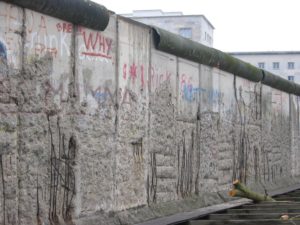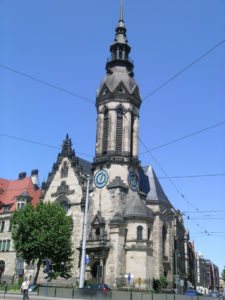There is something to be said for being older than, say, fifty: Chances are you remember the fall of the Berlin Wall, which in my case came with a surprise revelation about history.

I was in my living room in upstate New York that November 9, 1989, when a friend practically ordered me to turn on the TV because “something big is going on in Berlin.”
And so I found myself staring at the screen an ocean away from Germany, speechless. Throngs of people were crossing through the Berlin Wall, even dancing on top of that ugly concrete edifice that, mere hours earlier, as well as since before I was born, had been part of the deadliest border regime in the world.
From the perspective of 2022, it would be easy to file away those dramatic scenes as “history,” in that shorthand use of “it’s in the past, so we don’t need to think about it anymore” – or to assume, with the narrowed view of hindsight, that things simply had to happen the way they did.
But that view of history keeps us from understanding, in the words of historian Mary E. Sarotte, “the significance of accident, contingency, and above all, the agency of local actors.”
That’s what struck me as I sat glued to the TV that November afternoon, watching complete strangers laugh and cry in each other’s arms. I did not know anyone on either side of the now-defunct Berlin Wall, nor in the GDR – that mysterious other Germany, as it appeared from the vantage point of my West German youth. But what was happening there was without a doubt history, and it was happening to real people who were alive at the same time as I.
The thought surprised me. In school, I had gotten the impression that history was the realm of people who’d been dead for hundreds of years – if they had ever really been alive at all.

Wikimedia Commons, Gerald Praschl CC BY-SA 4.0
If history came alive for me in a general sense in 1989, it became more personal in the years since then. I became curious about my country’s four-decade-long division, about life in the other Germany, and about the events of 1989. In the course of my explorations, I met Siegbert “Siggi” Schefke, then 30, one of the first East Germans to walk into West Berlin that historic evening. I learned that what he and his friend Aram Radomski did on October 9, 1989, was even more significant: That evening, the two crouched in the midst of bird droppings on a church spire in Leipzig, training a video camera on the boulevard below. Their mission was to secretly film the largest yet of the protest marches that earlier that year had begun as Monday peace prayers. They knew that massive contingents of army and police battalions had been stationed in Leipzig.

for their clandestine video on Oct. 9, 1989.
Wikimedia Commons, Rabax63, CC BY-SA 4.0
“Of course we were afraid,” Siggi tells me. “Everyone was. We had no way of knowing whether soldiers and police would shoot at their fellow citizens.” In fact, they had good reason to believe that shots would be fired; their own government’s track record over the decades pointed to exactly that. Only that June, Erich Honecker, the East German head of state, had praised the Chinese government for deploying tanks and assault rifles against the peaceful protesters in Beijing’s Tiananmen Square. And only on October 7, the 40th anniversary of the GDR’s founding, police in several East German cities had brutally beaten protesters.But no shots were fired in Leipzig that night, and that march became a key moment in the Peaceful Revolution.

whose spire Siggi and Aram
filmed the Oct. 9 march. ©Kerstin Lange
A miracle, I often think. But there was also the discipline and intention of the marchers: in between chanting “We are the people,” they reminded each other “No violence.” There were the appeals of six prominent Leipzig citizens on the radio throughout the day, including the chair of the local SED (Socialist Unity Party) and Gewandhaus orchestra director Kurt Masur, imploring marchers not to let themselves be provoked. Perhaps most importantly, there were the police and army commanders who decided that they would not be responsible for a bloodbath.
And still, what if only one soldier had pulled the trigger out of sheer anxiety, even by mistake? We will never know, but that is not the point of asking such questions. The point is that somehow, everyone present in Leipzig that night mustered enormous courage and responsibility – and that history could have unfolded differently.

(photo courtesy Siegbert Schefke)
The way it did unfold, Siggi and Aram managed to get their video tape to a West German TV station. News of the gigantic peaceful protest spread like wildfire, ever more East Germans took to the streets, Honecker resigned; the Politburo reconstituted itself almost daily. On November 9, a government spokesman accidentally announced that a new travel law would take effect “right now.” And the rest is … history, yes, but also the result of accident, contingency, and the agency of local actors. Real people.
Fast forward three decades. The euphoria about the fall of Berlin Wall has long since faded; the world has changed in ways no one could have imagined. Lately, the streets of eastern Germany have filled with protesters again. The complaints cover a broad range of issues: soaring energy prices, government policies regarding refugees, the climate, the war in Ukraine. Protests over these issues are not limited to eastern Germany, but here, they have a special flavor. Many placards say things like “GDR 2.0”, asserting that today’s Germany is again a dictatorship. The marches take place on Mondays, as they did during the Peaceful Revolution.

©Kerstin Lange
For many here, the time since 1989 brought profound upheaval, like massive unemployment and the disorientation, not unlike culture shock, of having to learn a new system where everything works differently: from schools to work culture to applying for a driver’s license. Sociologist Steffen Mau calls the resulting fatigue Veränderungserschöpfung, the fatigue of change.
And still. Today’s Germany a GDR 2.0? That would be hard to square with the gains in freedom – free elections, the freedom to protest, and no restrictions on travel. What about the GDR’s deadly border, and the Zersetzung – psychological disintegration – and worse visited on its own citizens by the Stasi? Indisputable, too, are the billions of D-Marks and Euros spent on infrastructure in the East. On the other hand, wages and savings still lag behind in the eastern federal states, as do the numbers of eastern Germans in leadership positions. And there are more subtle aftereffects of reunification that still echo in the lives of many, especially older, eastern Germans, paralleling societal rifts in other countries: rifts between people who feel left behind or slighted by others whom they often describe collectively as elites. Sociologist Arlie Russell Hochschild showed this for the U.S. in her book Strangers in Their Own Land.
Feelings matter, as do the people who experience them. But then there are those who instrumentalize them for political gain, such as Germany’s far-right AfD (Alternative for Germany) party. Many of its leaders hail from western Germany, yet claim to “complete the Wende” (literally the “turnaround” of 1989).
Many misunderstood the chants of “We are one people” as a call for a nationalist awakening.
I speak with Siggi again. He points out that eastern Germany was fertile soil for right-wing propaganda after Reunification; that despite the GDR’s antifascist stance it often turned a blind eye to neo-Nazi activity. “Many misunderstood the chants of ‘We are one people’ as a call for a nationalist awakening.”
Ironically, Siggi himself has been the target of right-wing aggression both in the GDR and when working as a TV journalist in recent years, covering the aftermath of racist attacks. Along with several other GDR dissidents, he has signed a resolution condemning the misuse of the Peaceful Revolution by sympathizers of the AfD and the anti-Muslim movement PEGIDA.
Accident, contingency, and – “above all” – the agency of local actors. There is little any of us can do about accident and contingency, except to try to understand their role. But agency is a different matter: This is the wiggle room each person has. To participate in a march or not, to understand our own motivations and those of people who promise to speak for us, to channel frustration against a vague “elite” or work towards a solution for the many problems we face. There is no guarantee of success. But we are the real people alive today, at this moment in history.


Bringing history and this historic moment to life. So much we have not known…. such bravery in the face of violence, and knowing there are cracks in the seeming solid walls, is very encouraging. Love how you were able to personalize this chapter.. nice job, Kerstin!
Thank you for your thoughts Julie! I agree, it helps to remember that there can be cracks even in seemingly solid walls…
I always feel a little better informed by keeping up with your blog posts. Thank you for your insights.
That’s great to hear. Thanks Eric!